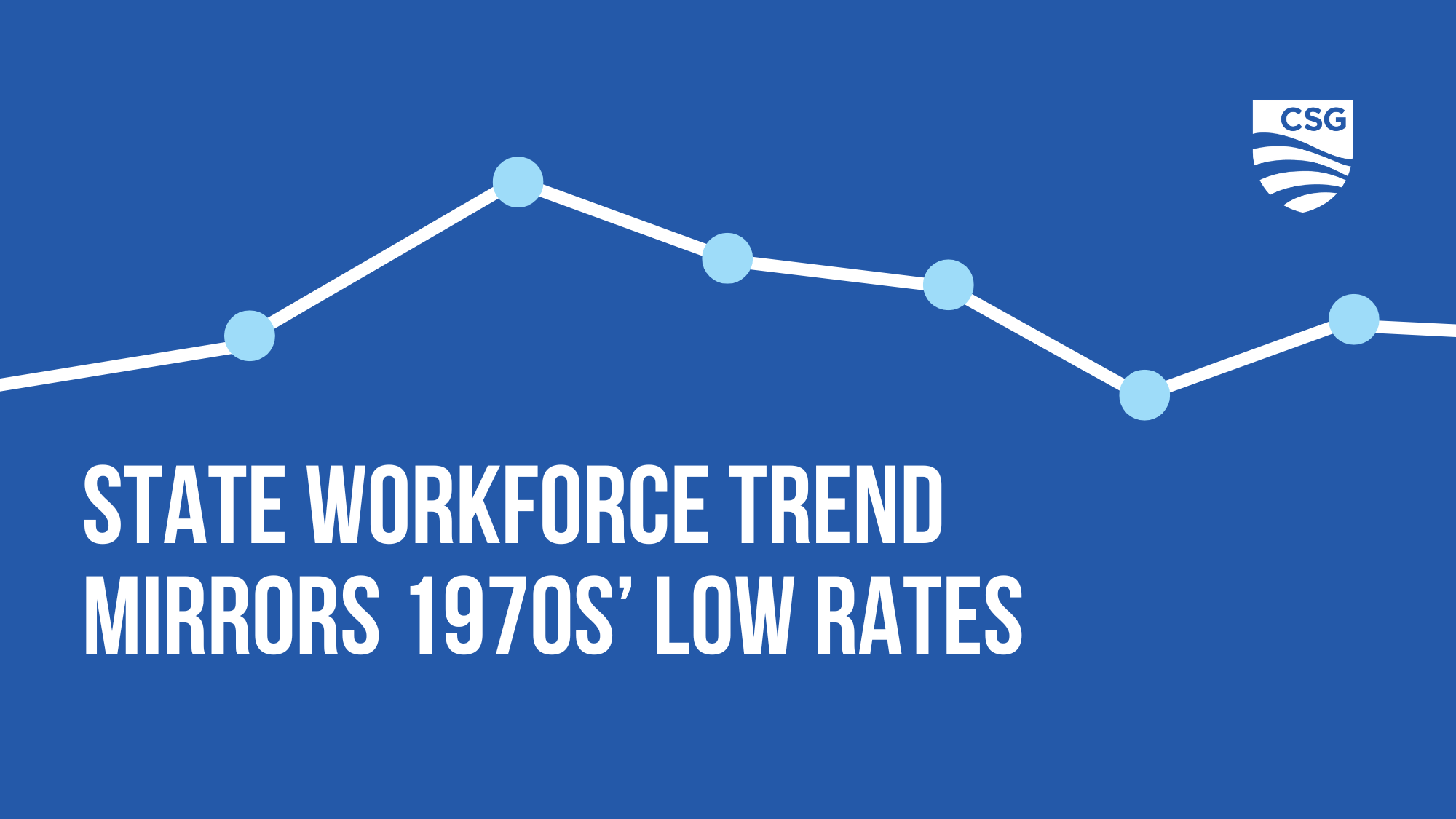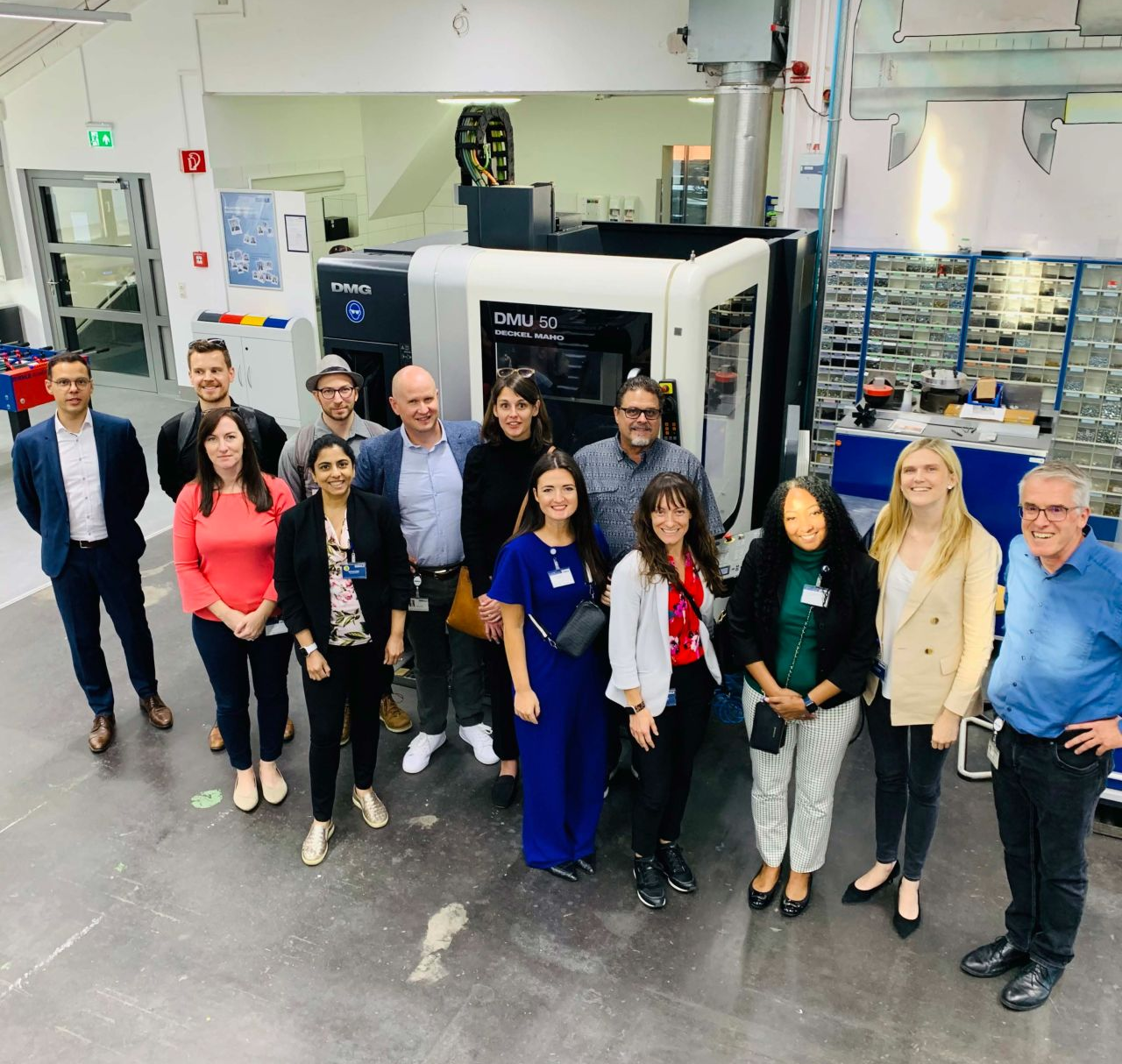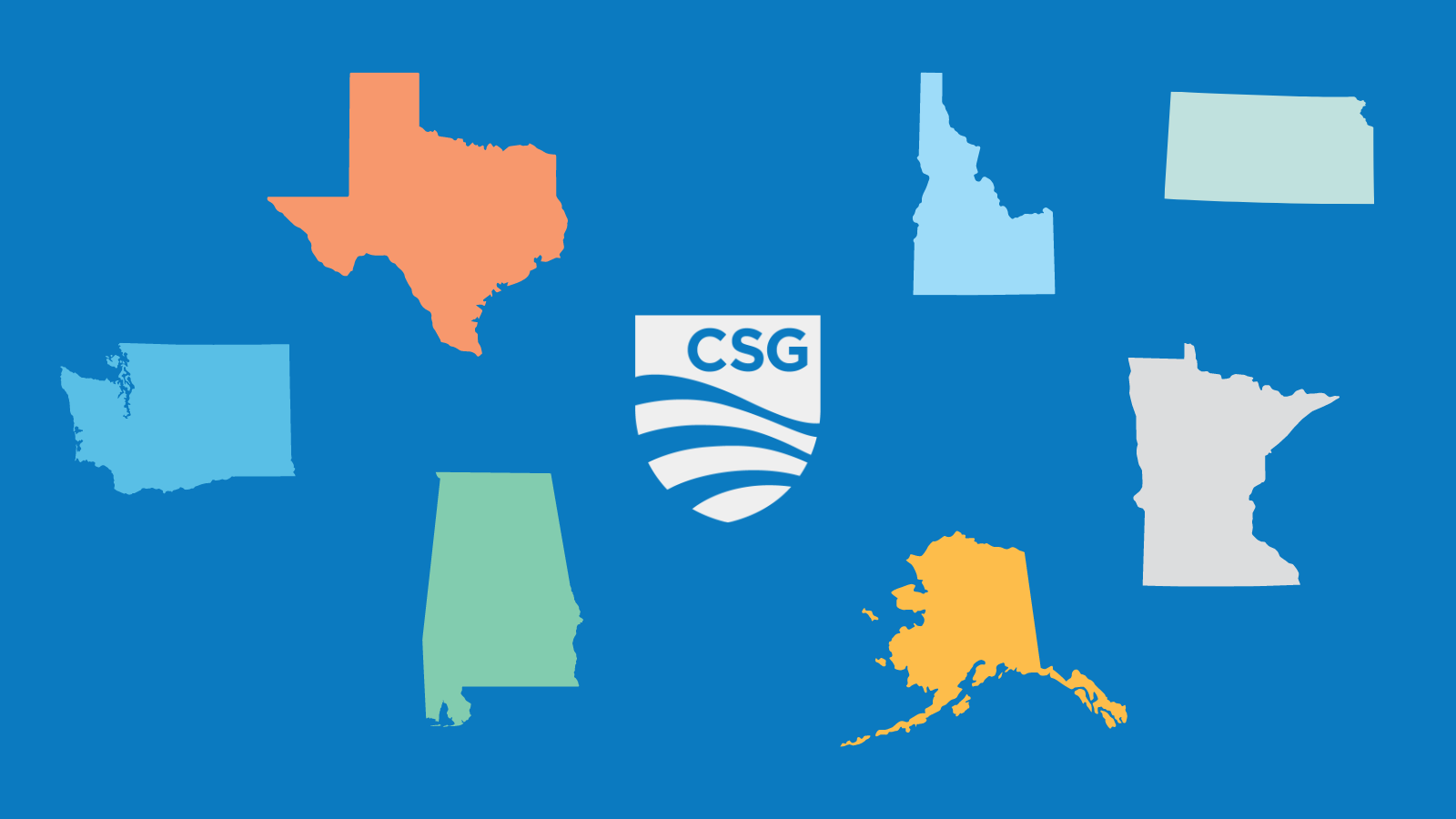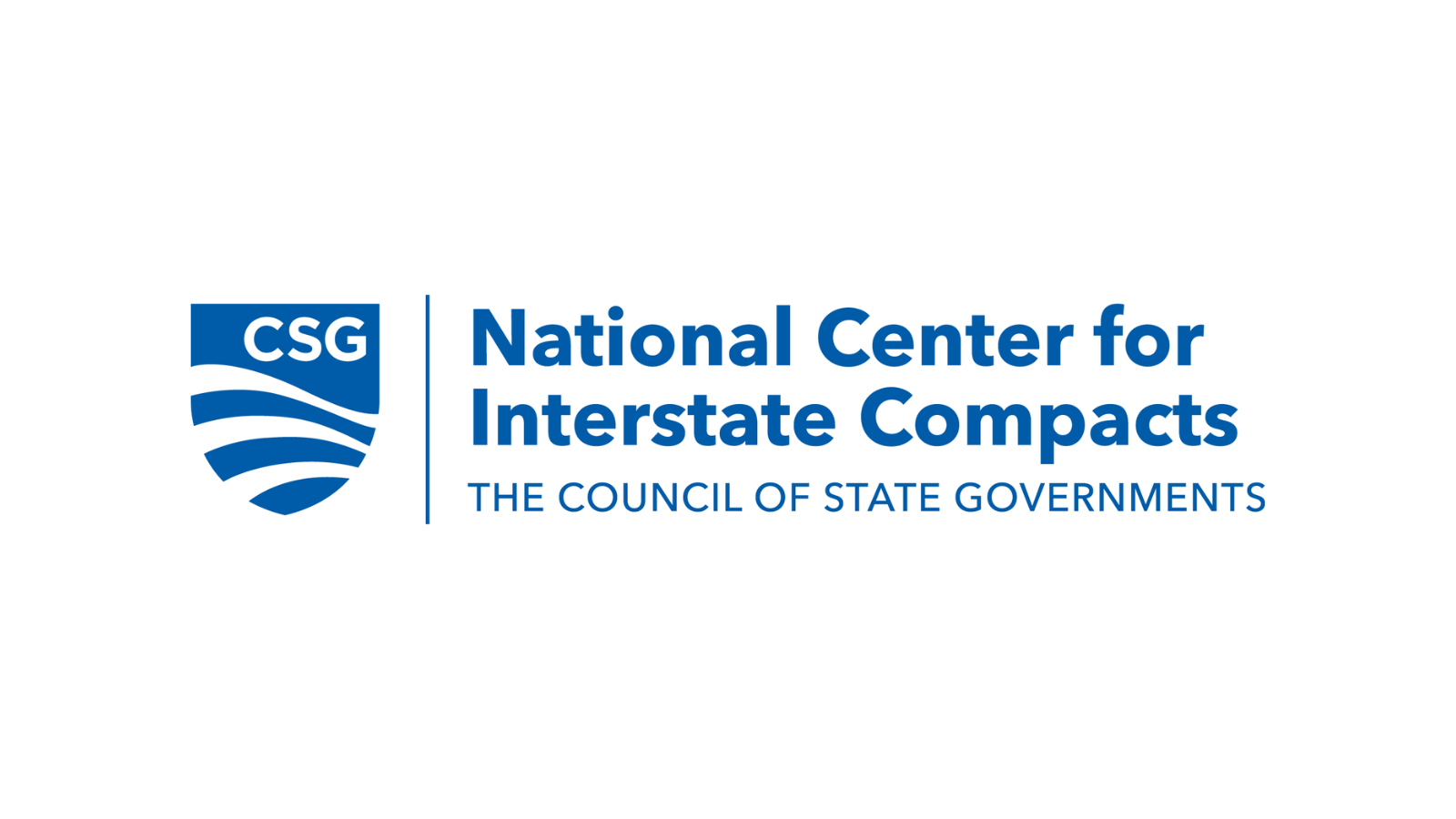State approaches to AI and workforce vary, with some tying investment in emerging technologies to job creation. Similarly, some states, including Michigan, are investing in AI to enhance talent attraction and support jobseekers in identifying available career opportunities.
Continue readingJapan Hosts Delegation, Promotes Education, Engagement with the World as Keys to its Future
By Sean Slone, Senior Policy Analyst
CSG Senior Policy Analyst Sean Slone traveled to Japan in February as a delegate to this year’s Local Government Exchange and Cooperation Seminar hosted by the Council of Local Authorities for International Relations (CLAIR).
Each year, CLAIR invites a group of senior state and local government officials and staff from the organizations that serve them to experience Japan firsthand and engage in enlightening information exchanges and networking. The Japan Local Government Centre, CLAIR’s U.S. office in New York City, is a longtime partner of CSG and other state and local government organizations. Slone was chosen by CSG leadership to participate based on his long tenure at CSG.
This year’s delegation included a mayor from Washington, a state senator from Hawaii and representatives of the International City/County Management Association, National Association of Counties, National Conference of State Legislatures, Sister Cities International, and the Association of Municipal Managers, Clerks and Treasurers of Ontario. The group spent time in Tokyo learning about the local government system before riding the bullet train to Okayama Prefecture for a regional study tour in the southern part of Honshu Island on the Seto Inland Sea.
The United States has a lot riding on the success of Japan. For one thing, the country is a major market for U.S. goods and services, including agricultural products, commercial aircraft and pharmaceuticals.
Moreover, in 2022, Japanese automakers manufactured about 2.82 million vehicles at production facilities in the United States, supporting more than 2.3 million U.S. jobs. Those automobile manufacturers play an essential role in the U.S. economy having invested more than $60 billion in manufacturing facilities over the past 40 years.
Photo: CSG Senior Policy Analyst Sean Slone (second from right) poses for a photo alongside his CLAIR Fellowship Exchange Program attendees at the Korakuen Garden in Okayama on Feb. 15. Photo credit: Natalie O’Donnell Wood, National Conference of State Legislatures.
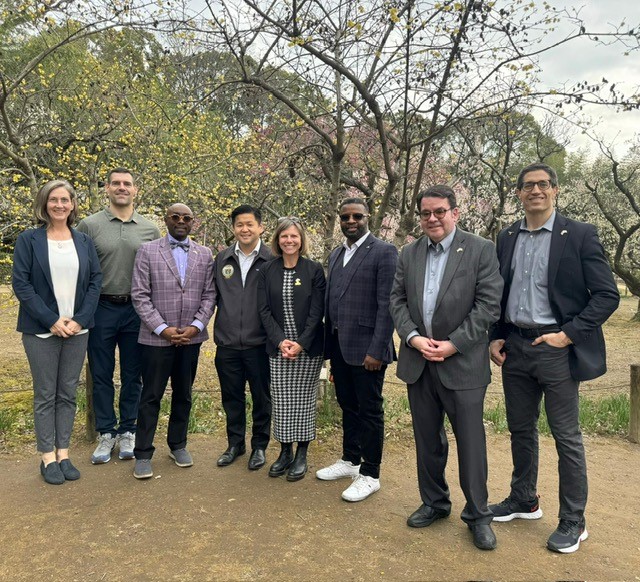
Located near the CSG national headquarters in Lexington, Kentucky, is the community Georgetown, which has benefited considerably from the presence of one of those manufacturers: Toyota Motor Manufacturing. Toyota set up shop in 1986 and now employs more than 9,300 individuals. By one estimate from a few years ago, if indirect jobs and spin-off companies are factored in, the number of jobs supported statewide is closer to 30,000.
State policymakers around the country recognize that maintaining the economic impact of a company like Toyota requires building and maintaining an educated workforce. But in recent years, that is where the United States has struggled, for several reasons. It’s estimated that the U.S. has lost as many as 1.4 million workers from the labor force since the start of the pandemic in February 2020. Meanwhile, the birth rate in the U.S. has decreased since the Great Recession, declining almost 23% between 2007 and 2022. Whereas in 1950, the average American woman gave birth to three children, today that number is around 1.6, significantly below the replacement rate of 2.1 children needed to sustain a stable population.

Photo credit: Commissioner Larry Johnson, DeKalb County, GA

Photo credit: Sean Slone

Photo credit: Sean Slone
While we may not talk much about such declines in the United States, Japanese government officials are very concerned about how a declining population and birth rate on the island nation may impact their future. It was a concern expressed by many of the officials the CLAIR delegation met with in February. However, that concern may ring slightly hollow as you’re wandering the busy streets of Tokyo’s Shinjuku neighborhood on a weekend night, making your way through a busy train station to catch the shinkansen — Japan’s smooth-running bullet train — or jostling with hundreds of other tourists for the best view at Tokyo Skytree, the 2,000-foot-high broadcasting and observation tower that affords a commanding sense of the scope of the world’s most populous city.
Still, government officials predict that most Japanese prefectures will see significant declines in population between now and 2050. Eleven prefectures will each see their population shrink by more than 30%, according to the National Institute of Population and Social Security Research. Moreover, the Health, Labor and Welfare Ministry reported that the number of babies born in 2021 fell by nearly 30,000 from the previous year. At the same time, the number of people age 65 or older in Japan reached a record high of 36.27 million in 2022.
The reason for the concern in Japan is that the regions expected to experience the biggest population declines are likely to face declining tax revenues and economic contraction, making it difficult to maintain infrastructure and local government services. And while Tokyo is expected to remain hugely popular both with Japanese and transplants from elsewhere — its population is expected to increase 2.5% over the same period — many believe the concentration of people in the city is a matter of some urgency.
Shunsuke Kimura, a professor in the Graduate School of Governance Studies at Tokyo’s Meiji University, told CLAIR seminar delegates the nation’s long-term vision for taking action against a shrinking society includes four objectives:
- Generating stable employment in regional areas.
- Creating a new inflow of people into regional areas.
- Fulfilling the hopes of the young generation for marriage, childbirth and parenthood.
- Creating regional areas suited to the times with safe and secure living and cooperation with other regions of the country.
One factor that many believe could help lift Japan’s outlying regions — and one that U.S. communities might want to take some cues from — is a focus on education that emphasizes both civic engagement at home and study abroad programs that allow students to experience other parts of the world.
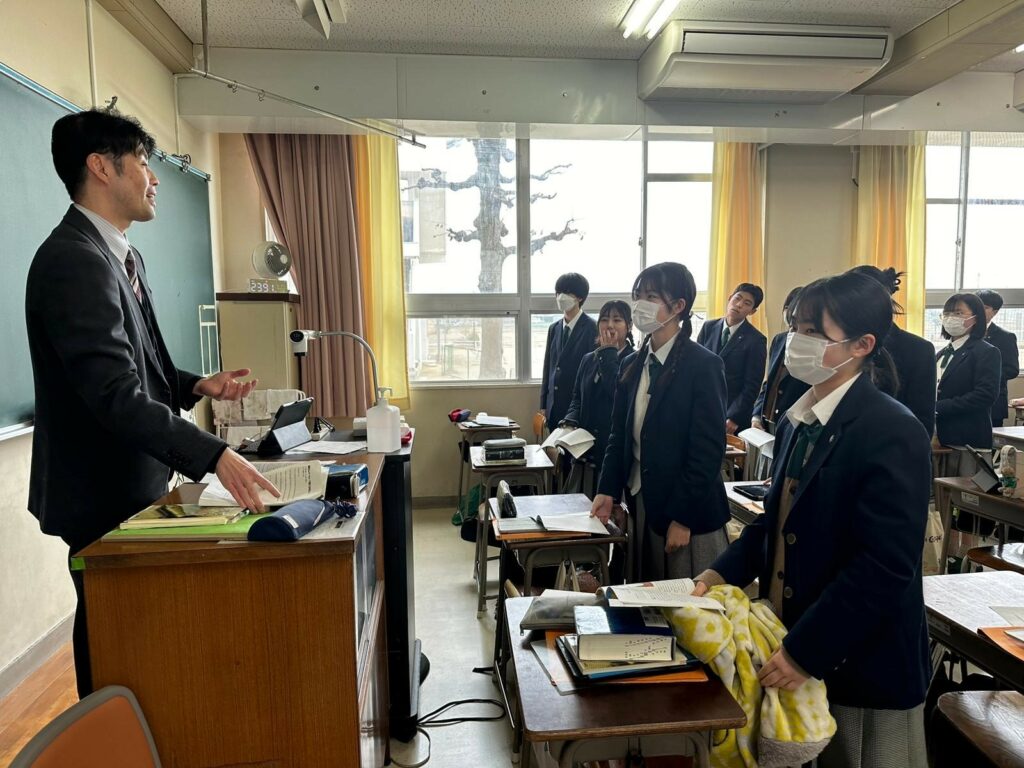
Photo credit: Commissioner Larry Johnson, DeKalb County, GA
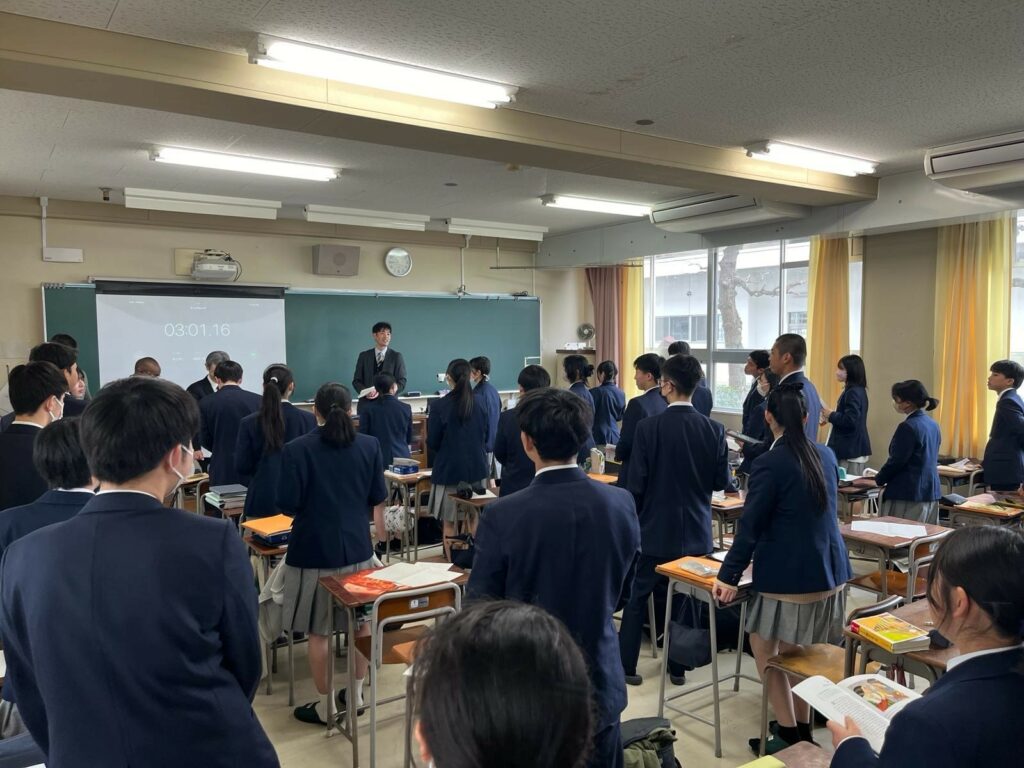
“Romeo and Juliet” at Joto High School.
Photo credit: Mayor Mary Lou Pauly, Issaquah, WA
During a visit to Okayama Prefecture, CLAIR delegates had the opportunity to visit Joto High School and hear about the school’s system for “raising global leaders.” School officials detailed characteristics they aim for in their students, including both support for the local community and a global mindset. They said they seek to nurture creative and critical thinking as well as an ability to use advanced English. The school emphasizes three initiatives, including studying community issues, deepening cultural exchange, and fostering independence and autonomy. As part of a three-year program, students learn cross-curriculum research skills, visit local companies to learn about global issues, conduct empirical research with an emphasis on regional fieldwork, and in year three, do personalized, in-depth research and thesis writing in both English and Japanese, while focusing on four courses: humanities and social sciences, international studies, science and math, and music.
In one classroom at Joto, delegates observed students studying and discussing a simplified version of Shakespeare’s “Romeo and Juliet” in English (it was the week of Valentine’s Day). In another classroom, students were invited up front to play back elaborate musical compositions they had composed. Down the hall, others were conducting experiments with beakers and Bunsen burners.
Perhaps most impressive was a presentation from a young girl titled “Visualizing Abstract Japanese Aesthetics.” It was a highly conceptual, multi-disciplinary exploration of complex themes such as the core concept to Japanese aesthetics of “wabi-sabi” — the notion that beauty and enjoyment can be found within the deterioration of worldly things. Or as the young student put it, “beauty in decay.”
Joto students also can experience numerous international exchanges, including long-term or short-term study abroad programs in Australia, Canada and the United States.
Student exchange is also a focus at Okayama Prefectural University, the 30-year-old higher education institution in the city of Soja that was also on the delegation’s travel itinerary. University officials there highlighted global partner universities and international networks across North America, Europe, Asia, Oceania and Africa. The university serves a student body of just over 1,700 studying in areas like health and welfare science, computer engineering and design. One student detailed her year of study in Toronto at the University of Guelph, where she created a club for fellow students on making vegetarian Japanese food.
The international focus highlighted across Okayama seemed to reflect the life experience of Ryūta Ibaragi, the prefecture’s dynamic and long-serving governor, who in 1995 received a Master of Business Administration from the Stanford University Graduate School of Business. The governor, whom delegates got the chance to meet and exchange gifts with, has established as one of his priority initiatives reclaiming Okayama’s status as the “Education Prefecture.”
Photo: Ryūta Ibaragi, governor of Okayama Prefecture, speaks to members of the CLAIR delegation at the Okayama Prefectural Office on Feb. 14. Photo credit: Sean Slone.
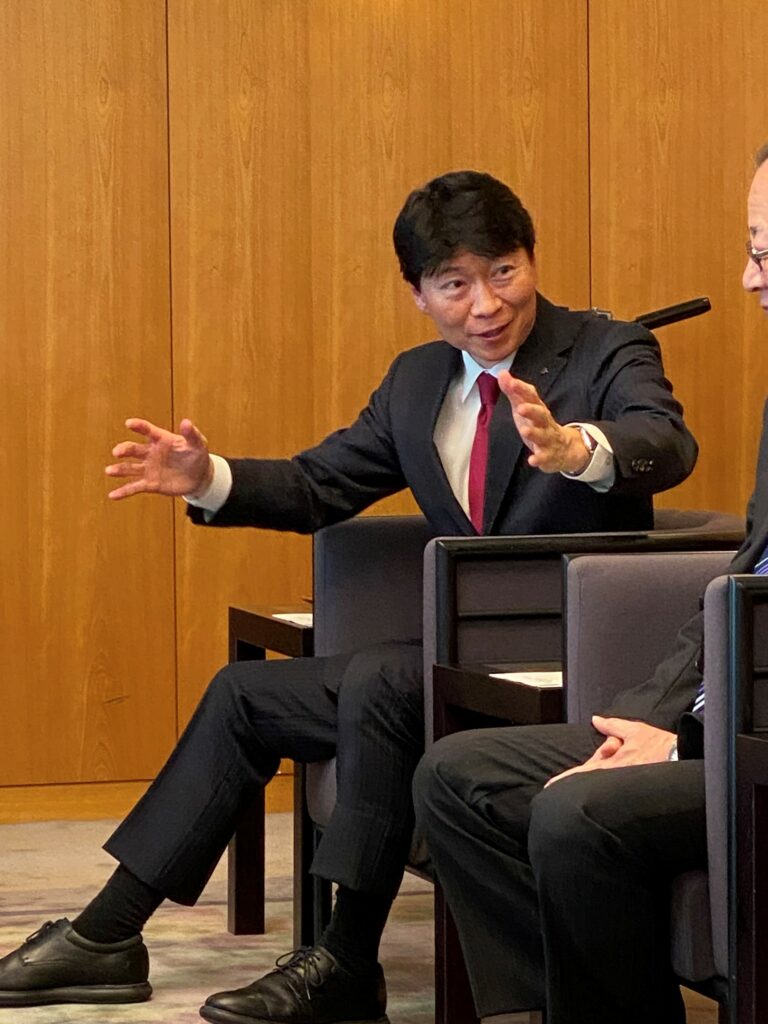
While education may be a key to the future of many places in Japan as the country tries to reverse course on its shrinking society, another concern has emerged more recently in the island nation: a shrinking economy. Last year, Japan lost its spot as the world’s third-largest economy, contracting in the fourth quarter of 2023 and slipping into recession as it fell behind Germany.
But there aren’t many countries in the world where recession would look quite like this. There is commerce everywhere in Japan. From the high-end retailers at every multi-story department store in Tokyo to the businesses clustered around Japan’s train stations to the ubiquitous convenience stores where you can get a surprisingly decent late-night snack and cook and eat it on-site. Wandering the well-stocked aisles of the enormous Don Quijote discount store in Shinjuku, it begs the question: Who is buying all this stuff? Isn’t there a recession going on?
One place providing respite from the non-stop commerce is the peaceful Okayama Korakuen Garden, a 300-year-old Japanese garden that is considered one of the nation’s three great gardens. Unlike one of the gardens of Europe, where the goal is to keep things looking much as they did in the time of long-dead monarchs, Korakuen will not be the same 50 or 100 years from now, we were told. It is designed in the “scenic promenade” style, which presents the visitor with a new vista from every path or tea house on the property. And as an Italian guide told the delegation, the garden is a “moment in time.” It is a memento mori — a reminder of impermanence and the inevitability of death, a reminder of the beauty in decay. Like the cherry blossom — Japan’s enduring symbol of beauty and mortality — it is ephemeral, here one day and gone the next.
As the group prepared to leave Okayama Prefecture and return to Tokyo, delegates were invited to give their impressions of the trip. One of our fellow travelers suggested he needed a couple more days to experience Japan. I told the CLAIR and prefectural staff I needed a couple more lifetimes. But I get the feeling that if I were to return to Japan every year and immerse myself in the country, it would be difficult to ever truly know Japan. Like the garden, the country is a moment in time. A remarkable, unknowable place where past and present collide, and where its residents are trying to shape a bright future despite ominous headwinds.
Meeting the Mental Health Needs of the Public Sector Workforce
Public sector workers — including civil service, public health, law enforcement and more — are essential to effective state government, as they provide important services for all residents. However, the weight of this critical work can take a heavy toll on their mental health. To address their needs, policymakers and community partners can increase access to vital supports that help state and local workforces address the unprecedented mental health crisis among government employees.
Continue readingState Workforce Trend Mirrors 1970s’ Low Rates
The labor force participation rate is the percentage of the civilian noninstitutionalized population that is either working or actively looking for work. Rather than a new phenomenon, the decline of states’ labor force participation rates is a structural trend dating to the 1970s.
Continue readingProposed Enhancements to the National Apprenticeship System
By Joe Paul and Mary Wurtz
On Jan. 17, the Office of the Federal Register published a notice of proposed rulemaking from the U.S. Department of Labor titled “National Apprenticeship System Enhancements.” The proposed rule changes present a range of updates to 29 CFR Part 29, the regulations governing apprenticeship labor standards and the National Apprenticeship System. The 60-day period for public comment on the proposed regulations closes March 18.
The proposed changes are summarized in three subparts, as a resource for policymakers, apprenticeship professionals and others to make informed comments before the deadline passes.
Subpart A addresses proposed changes to the definitions and standards for registered apprenticeship programs. Primarily, proposed changes under section 29.8 reinforces current apprenticeship standards, requiring a minimum of 2,000 on-the-job training hours for all programs and 144 related instruction hours per each 2,000 hours on the job. Amendments in subpart A also seek to standardize and centralize existing practices for program registration, the signing of apprenticeship agreements and more.
Subpart A also updates definitions for key components of registered apprenticeship and adds definitions for terms like “pre-apprenticeship,” which have been used by the federal government for several years but never formally added to regulations. Proposed changes also clarify the requirements for an occupation to be deemed “suitable” for apprenticeship and the federal government’s ultimate authority in determining an occupation’s suitability.
Subpart B, beginning with proposed section 29.24, was developed in collaboration with the U.S. Department of Education to increase student apprenticeship capacity. Acknowledging participation of high-school-aged youth in registered apprenticeships has been limited. The goal is to expand apprenticeship opportunities for high school and postsecondary students. Subpart B introduces core requirements that blend labor standards and industry skillsets into career and technical education (CTE) apprenticeship programs. This requires coordination with each state’s CTE and apprenticeship registration agency to increase the development and registration of CTE-based apprenticeship programs.
Emphasizing the skills found in industry frameworks, the model increases related instruction hours and on-the-job training targeting youth, specifically those aged 16-24, in high school or already engaged in postsecondary education. The programs will be aligned with Perkins CTE programs, and state CTE agencies will play a critical role in their development and implementation. The apprentice will gain industrywide skills, recognized postsecondary credentials and pathways to employment, the types of registered apprenticeships outlined in Subpart A, and opportunities for further education.
Subpart C reflects the Department of Labor’s emphasis on data collection and the related metrics of success. The subpart acknowledges that technological advances have led to increased emphasis on data-driven decision-making and the role of the Registered Apprenticeship Data and Program Information Data System (RAPIDS) in enhancing collection, reporting and analysis capabilities. The changes include collecting individual participant information, tracking apprentice progress and new measures for evaluating success. Within the proposed changes, the Department of Labor recognized concerns with information disclosure, privacy and data protection while balancing the need to enhance the existing apprenticeship data systems.
Subpart C also outlines recognition for the responsibilities of state apprenticeship agencies, duties and functions of state apprenticeship agencies — including an apprenticeship state plan — and reciprocity issues that may arise with registration. The proposed rulemaking also includes requirements for state apprenticeship agencies to submit quarterly apprentice and sponsor data to RAPIDS, with the goal of improving data quality, increasing agency transparency and providing accountability within registered apprenticeships.
All proposed changes by the Department of Labor seek to align the U.S. National Apprenticeship System with international labor best practices and recent research on registered apprenticeship programs. Employers, policymakers, apprentices, labor organizations and others can submit comments on the proposed rule changes by March 18.
For questions, please contact Mary Wurtz via email at [email protected] or Joe Paul at [email protected].
CSG Travels Abroad to Expand Apprenticeship Education
By Trey Delida
Last week, CSG staff and members attended the 2023 Transatlantic Apprenticeship Study Trip in Germany. From Stuttgart to Munich, Bayreuth to Berlin, attendees saw firsthand how well-developed apprenticeship programs impact communities.
Hosted by DIAG USA, a nonprofit that gathers stakeholders based on the example of German apprenticeship programming, the goal was to show how one country successfully implements apprenticeships.
Other organizations from the United States included the Urban Institute, the Colorado Office of Apprenticeship, the Workforce Development Board system in California, members of the Pennsylvania Senate and more.
As states face workforce shortages across sectors, apprenticeships could be a viable solution in expanding work-based learning and upskilling workers.
“As rapidly changing technology is revolutionizing the way we work, we are on the forefront of preparing our partners for this transformation,” DAIG USA posted on its LinkedIn. “Many companies are looking for a sustainable pipeline of talent that more effectively supports their goals for growth and profitability. We believe that Apprenticeship programs offer an innovative and win/win solution.”
The trip included visits to German businesses, government offices, schools and the German Chamber of Commerce, all of which utilize apprenticeships as a career pathway.
CSG has partnered with DIAG USA for several years. Center of Innovation Deputy Director of National Programs Sydney Blodgett shared that the trip allowed attendees to learn about the established German apprenticeship system firsthand.
“We visited the different stakeholders involved in workforce development and learned how they encourage folks to get into different career pathways and all the different entry and exit points,” Blodgett said. “We’ve worked with them for a couple of years now, and as apprenticeships are growing in the US, people are looking at alternative pathways to careers as the student debt crisis grows in the U.S., people are really looking at other ways to get into careers.”
CSG works extensively with several organizations and stakeholders on the expansion of apprenticeships in the United States.
For more information on CSG’s work to improve access to apprenticeships, click here.
Wisconsin’s Braided Funding Efforts
By Enmanuel Gomez Antolinez
While numerous public, private and nonprofit programs and services are available to support the employment of youth and young adults with disabilities (Y&YADs), a lack of coordination between stakeholders can result in service gaps and duplication. Wisconsin used braided funding strategically to increase coordination and alignment between employers, service providers, education sponsors and workforce systems, enhancing Y&YADs services and outcomes. Braided funding is a financing method that uses multiple funding streams to support the total cost of a program or service. It ensures that funding goes where it is most needed, encourages interagency coordination and ensures the appropriate program and administrative costs are properly charged to each separate funding stream. According to the U.S. Department of Labor, Office of Disability Employment Policy, braided funding can be used to:
- Support an individual with a disability with the goal of pursuing, gaining, or keeping Competitive Integrated Employment (CIE),
- Support Pre-Employment Transition Services, and
- Support post-secondary preparation and transition activities.
The U.S. Department of Health and Human Services’ “Braiding Federal Funding to Expand Access to Quality Early Care and Education and Early Childhood Supports and Services: A Tool for State and Local Communities” discusses this in more detail.
While this tool has an early education focus, the analysis it utilizes is equally applicable in a transition setting. Specifically, as outlined in the tool, states and local governments may consider implementing the following strategies to support and expand transition services to Y&YADs through braided funding by:
- Identifying funding streams.
- Identify what funding sources are available in your state or locality and identify how this funding can be used to achieve specific goals.
- Developing an inventory of funds known as a fiscal map, directed toward a particular population (e.g., Y&YADs) or service group. A fiscal map can be used to:
- Recognize duplicative funding streams as well as gaps in funding.
- Establish methods to use funds more strategically.
- Identifying eligible populations and comparing funding requirements.
- For many funding streams, there are rules and restrictions that govern the use of the funds. Therefore, it is important to identify eligible populations and understand the differences in eligibility and reporting requirements among various funding streams available in your state or locality.
- Building and initiating data-sharing agreements to make it easier for state and local organizations to braid funds.
- Developing shared goals and a plan for collaboration.
- Permit local agencies, organizations, task forces, councils or committees to perform coordinated planning and funding functions outside a formal state framework.
- Use interagency planning groups to coordinate funding for specific objectives.
- Building state or local programs that use multiple funding streams rather than leaving it to individual provider level to pursue different funding streams.
- Developing governance structures to support collaboration between agencies and other key players in state or local entities.
Wisconsin is one state that engages in braided funding to support Y&YADs. Wisconsin’s 2020-23 Combined State Workforce Innovation and Opportunity Act (WIOA) Plan prioritizes and directs state agencies to identify opportunities for braided funding to provide effective employment services to individuals with disabilities. Wisconsin’s WIOA Plan also directs cost-sharing to be negotiated among state entities, such as education, vocational rehabilitation (DVR) and local entities such as long-term care and mental health agencies. For example, cost-sharing may be negotiated among DVR, the school district and long-term care or mental health programs when there is an overlap in educational and employment/rehabilitation goals and services. This negotiation increases coordination between the various parties to ensure their specific funds contributed to the program or service are used for their designated purposes.
Similarly, the Wisconsin Departments of Health Services, Workforce Development and Public Instruction developed a comprehensive Transition Action Guide (TAG). This guide outlines a strategic approach to help Wisconsin state and local governments identify overlaps or gaps in service provision in the areas of communication, coordination and service delivery for Y&YADs transitioning from school to work. It lists funding sources and their eligibility requirements so agencies can pursue braided funding opportunities. The resource also discusses cost-sharing agreements among agencies and when these agreements are appropriate.
For more information and state examples of the benefits of braided funding efforts, review CAPE-Youth’s “Improving Transition Services for Youth and Young Adults with Disabilities through Braided Funding.”
Latest ‘Guideposts for Success’ Offer State Leaders Tools to Educate, Support Employers
By Trey Delida
Since 2005, the “Guideposts for Success” have equipped state leaders with up-to-date, innovative practices that increase the opportunities for youth and young adults with disabilities to transition into the workforce.
The latest brief, “Guideposts for Success: States Engaging Employers through Policy,” serves as a model for policymakers by providing them with the tools necessary to educate and support employers in their states in hiring or providing learning opportunities for youth and young adults with disabilities.
According to Andrew Karhan, project director at San Diego State University’s Interwork Institute, the brief draws on state examples and actual conversations with employers who have experience in this process. As part of the project, Karhan collaborated with the Center for Advancing Policy on Employment for Youth (CAPE-Youth).
“The brief was compiled through a deep dive into research, the current best practices related to employer engagement and the comparable employer practices towards enhanced inclusion,” Karhan said. “Some previous policies in this space have not had the intended impact. Therefore, this brief was approached through a lens of improvement science, where we asked how we can introduce change ideas leading to improvement? The ideas presented here were born out of this research and conversations with employers and experts in the field to ultimately lead to these improvement ideas.”
The “Guideposts for Success: States Engaging Employers through Policy” is founded on six policy considerations, including:
- Developing structures for states to become model employers of youth and young adults with disabilities.
- Simplifying current incentives and introducing new incentives to encourage employers to develop inclusive workplace practices.
- Facilitating telework to adapt to changes in the world of work.
- Educating employers about the business case for their participation and support of youth and young adults with disabilities in work preparation programs.
- Assembling tools guided and developed in partnership with national centers and employer organizations and disseminating them at the state and local levels.
- Enhancing existing state workforce systems to foster equitable access.
The policy framework provides lawmakers and state leaders with evidence-based practices to aid youth and young adults with disabilities when obtaining employment through improved education.
“As youth transition into postsecondary environments or employment, it is critical for us to lay the necessary groundwork for them to move into employment in their field of interest and skill,” Karhan said. “The low employment outcomes of youth and young with disabilities have been well documented and, as a result, this brief offers new approaches and policy levers to help change this narrative.”
The development of “Guideposts for Success: States Engaging Employers through Policy” was led by CAPE-Youth, and is a collaborative effort of the U.S. Department of Labor Office of Disability Employment Policy, The Council of State Governments, the K. Lisa Yang and Hock E. Tan Institute on Employment and Disability at Cornell University, and the Interwork Institute at San Diego State University.
States Promote Apprenticeships to Expand Career Pathways during 2023 Legislative Session
By Mary Wurtz and Jackson Beauregard
According to the U.S. Chamber of Commerce, there are approximately 9.5 million job openings in the U.S., but only 5.6 million unemployed workers to potentially fill those roles. Considering these workforce shortages, many states pursue opportunities to expand work-based learning and to invest in upskilling existing workers through registered apprenticeship.
A registered apprenticeship is a high-quality, industry-driven career pathway that combines paid on-the-job training with classroom instruction to prepare workers for skilled careers in a variety of occupations. Historically, apprenticeships have been associated with trade professions, but now more than 1,000 occupations have been approved for registered apprenticeship by the U.S. Department of Labor, including roles in nursing, information technology, cybersecurity, human resources and more.
Registered apprenticeship programs can help states to address workforce shortages by empowering employers to grow their own talent pipelines. Through apprenticeship, employers invest directly in employees by providing training both on the job and in the classroom and mentorship by pairing apprentices with skilled mentors who support them throughout the program. Because apprentices learn while they work, programs typically have few to no minimum experience requirements. This makes apprenticeship programs a great tool for recruiting individuals who have traditionally faced barriers to employment and postsecondary training, like formerly incarcerated individuals or individuals with disabilities.
Throughout the 2023 legislative session, several states adopted strategies to expand registered apprenticeships, such as establishing apprenticeship grant programs, promoting the use of apprenticeships in previously non-apprenticeable occupations and providing additional benefits to individuals in apprenticeship programs.
Texas introduced HB 3723 (2023), which would establish a Rural Workforce Training Grant Program providing targeted funding for job-specific training, including apprenticeship programs, in counties with a population of less than 200,000. Grant money may be used to cover “costs associated with training materials, instructors’ fees, participant wraparound expenses, facility fees, administrative costs, and outreach, mentoring, and recruiting costs” for apprenticeships and other training programs.
Kansas enacted HB 2292 (2023), which establishes multiple grant funds and tax credits for employers offering apprenticeships in a variety of fields, including:
- A tax credit of up to $2,500 per apprentice for employers of apprentices in registered apprenticeship programs, up to 20 apprentices per employer. An additional tax credit of $500 is available per apprentice enrolled in a secondary or postsecondary career and technical education program.
- The Kansas Nonprofit Apprenticeship Grant Program Fund, offering $2,750 per apprentice to “eligible nonprofit employers and nonprofit healthcare employers,” with up to 20 apprentices per employer.
- The Kansas Educator Registered Apprenticeship Grant Program, established to fund tuition, fees, books and materials for education apprentices pursuing postsecondary education degrees. Education apprentices in Kansas can receive up to $2,750 per year for the purpose of increasing the number of qualified, credentialed teachers in the state of Kansas.
Idaho enacted SB 1069 (2023), which amends existing law to enable the State Board of Education to issue a certificate to a teacher who completed an approved registered apprenticeship program. These amendments create the possibility of state developed apprenticeship programs that meet the same standards as traditional teacher preparation programs and will be targeted toward individuals who have not earned bachelor’s degrees. Education degrees are often costly, and requirements of traditional programs, like unpaid student teaching, dissuade many individuals from pursuing their teaching certifications. Idaho is now one of more than a dozen states utilizing paid teacher apprenticeships to address these challenges.
Additionally, Idaho passed HB 16 (2023), which removes barriers for state agencies when hiring apprentices to fill public workforce shortages. Under new legislation, state agencies will be able to hire apprentices to fill shortages without counting them toward their annual budgeted full-time equivalent caps.
Washington enacted HB 1525 (2023), which expands the state’s existing child care subsidies to include individuals participating in a state registered apprenticeship program. Previous bill language included those in a registered apprenticeship, but the individual also needed to be a full-time student. Now, those who are in an apprenticeship program but are not students may receive the child care benefit. Apprentices are eligible to receive child care benefits for the care of one or more eligible children for the first 12 months of their enrollment in a registered apprenticeship program, if the individual’s annual adjusted household income does not exceed 75% of the state median income.
Minnesota enacted HF 1937 (2023), which increases the reimbursement amount that eligible service members and their family members are entitled to receive for costs associated with apprenticeship programs and other on-the-job training programs. The new law increases the aggregate amount of reimbursement from $10,000 to $15,000 over the eligible person’s lifetime, or a total of $3,000 per fiscal year. This reimbursement is in addition to benefits provided under the federal G.I. Bill, which provides funding for books, supplies and housing to veterans in approved apprenticeship programs.
These pieces of legislation build on the work accomplished by states in previous years to expand their apprenticeship systems. For example, in 2019, Alabama passed HB 570, which eliminated barriers to obtaining an occupational license by completing an apprenticeship program. Under the 2019 legislation, individuals who complete an apprenticeship may be granted an occupational license in that trade if the individual also completes all necessary examinations and meets other statutory requirements. The law also states that individuals who complete apprenticeship programs may not be required to complete additional testing requirements, affirming apprenticeships as high-quality preparatory programs for occupational licensure examinations.
Additionally, in 2022, Alaska passed HB 114, which directs the Department of Education and Early Development to “provide educational opportunities in the areas of vocational education and training and basic education to individuals over 16 years of age who are no longer attending school.” This includes encouraging engagement with “businesses and labor unions to develop a program to prepare students for apprenticeships or internships that will lead to employment opportunities.”
As states continue to expand their apprenticeship systems to build new career pathways, The Council of State Governments education and workforce team is available as a resource for policymakers. CSG provides states with no-cost technical assistance on registered apprenticeship, work-based learning and other topics related to workforce development. CSG can also help states to develop registered apprenticeship programs in state and local government to address their own public sector workforce needs.
For more information, contact CSG Policy Analyst Mary Wurtz via email at [email protected].
Interstate Teaching Mobility Compact Enacted Allowing Streamlined Licensing Pathways for Educators in 10 States
Licensing for the roughly 3.7 million teachers in the country has historically been a system with unclear barriers between states, making it difficult for educators to relocate and attain a teaching license in another state. Military spouses are particularly impacted by these limitations — they move residences between states frequently as their spouses are relocated to various posts and are often met with licensing barriers.
Recognizing these obstacles, in 2020 the Department of Defense entered into a cooperative agreement with The National Center for Interstate Compacts at The Council of State Governments. Authorized by Congress in the 2020 National Defense Authorization Act, the cooperative agreement provides funding for the development of up to ten new occupational licensure compacts. A compact for teachers was a priority for the Department of Defense.
Model legislation to join the Interstate Teacher Mobility Compact was released to states in November 2022 after more than a year of development, public comment and stakeholder review. In June, Oregon joined nine other states — Colorado, Utah, Kentucky, Oklahoma, Kansas, Florida, Alabama, Nebraska and Nevada — in fully enacting the compact legislation. With the addition of this tenth state, the compact became active — the fastest occupational licensure compact to do so.
“A military spouse shouldn’t have to choose between supporting their family and pursuing their profession. Thankfully, states are working together to ensure they won’t have to,” said David Adkins, executive director/CEO of The Council of State Governments.
“The ten states that have already enacted the Interstate Teacher Mobility Compact are reducing barriers to mobility for licensed teachers, and that’s good news to the many teachers in military families who will move to those states. CSG is proud to work with state officials and honored to partner with the U.S. Department of Defense to help create new tools to support military families. We look forward to continuing to be a resource for the ITMC Commission and its member states.”
Maintaining state sovereignty is one of the cornerstones of the Interstate Teacher Mobility Compact. The compact does not alter member states’ ability to regulate the teaching profession or teacher licensure. Member states take on some responsibility to grant licenses to out-of-state teachers, but any standing pathways to teacher licensure within the state will remain in place.
Addressing Teacher Shortages
While districts across the country are facing widespread teacher shortages, the Teacher Mobility Compact streamlines the systems of licensure mobility in member states.
“Teachers who relocated can find it difficult to navigate the waters of license issuance in a new state,” said Jimmy Adams, executive director of the National Association of State Directors of Teacher Education and Certification. “Many of these are professionals with years of experience who decide to leave the profession because of the barriers they confront.”
The teaching compact utilizes a different model than other interstate occupational licensure compacts. Compact member states submit licenses that are eligible for the compact and meet a set of criteria outlined in the legislation. To be eligible, a license must require a bachelor’s degree and completion of a state-approved program for teacher licensure like a teacher preparation program at a college or university. Teachers holding a compact-eligible license can apply for licensure in another member state and receive the closest equivalent license without submitting additional materials, taking state-specific exams or completing additional coursework.
This compact maintains each member state’s standards while recognizing the professional who holds this high-level license,” Adams said. “This compact will keep many teachers in the profession who may otherwise leave.”
Next Steps
Later this year, the compact member states will nominate their commissioners and the first meeting of the Interstate Teacher Mobility Compact Commission will be held to draft the bylaws and rules of the compact.
Currently, several states are still considering legislation to join the teaching compact. Those who join will also be included in this meeting if the legislation is passed before the first convening.
For more information about the Interstate Teacher Mobility Compact or to view the model legislation, visit teachercompact.org. To learn more about the National Center for Interstate Compacts and other occupational licensure compacts, visit compacts.csg.org.
About Occupational Licensure Interstate Compacts
Occupational licensure compacts create reciprocity between states while maintaining the quality and safety of services and protecting state sovereignty. Compacts result in a more efficient distribution of licensed workers by supporting practitioner mobility.
In addition to its work with the Department of Defense, the CSG National Center for Interstate Compacts led the development of interstate compacts for physicians, nurses, emergency medical services personnel, physical therapists, psychologists, occupational therapists, licensed professional counselors and audiologists/speech-language pathologists. More than 40 states and territories have adopted at least one of the compacts and over half have adopted three or more.
About CSG and the National Center for Interstate Compacts
Founded in 1933, The Council of State Governments is the nation’s only organization serving all three branches of state government. CSG is a region-based forum that fosters the exchange of insights and ideas to help state officials shape public policy. This offers unparalleled regional, national and international opportunities to network, develop leaders, collaborate and create problem-solving partnerships. Learn more at csg.org.
CSG has more than 75 years of experience promoting multi-state problem solving and advocating the role of the states in determining their respective futures. The National Center for Interstate Compacts is a policy program developed by CSG to assist states in developing interstate compacts, which have proved to be an effective mechanism for states to jointly problem solve. Learn more at compacts.csg.org.






